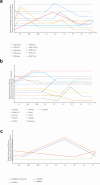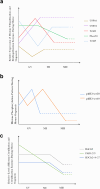A comprehensive review of histone modifications during mammalian oogenesis and early embryo development
- PMID: 40580240
- PMCID: PMC12206194
- DOI: 10.1007/s00418-025-02398-x
A comprehensive review of histone modifications during mammalian oogenesis and early embryo development
Abstract
The success of both oogenesis and early embryo development relies heavily on dynamic epigenetic regulation in which gene activity changes without affecting the underlying DNA sequence. Epigenetics works through two main mechanisms: DNA methylation and histone modifications. DNA methylation typically leads to gene silencing, while histone modifications can either activate or repress genes depending on the specific modification, histone type, and targeted amino acid residue. Histone modifications affect important DNA regulatory processes in which the histone core area as well as the N-terminal tails that extend from the core region are vulnerable to a variety of posttranslational modifications (PTMs), including methylation, citrullination (deimination), acetylation, phosphorylation, ubiquitination, SUMOylation, ribosylation, and lactylation. This review article focuses on what is known about changes in the histone modifications and how these modifications and their responsible enzymes operate throughout mammalian oocyte maturation and early embryo development, highlighting their crucial roles in these processes.
Keywords: Early embryo development; Epigenetics; Histone modifications; Oogenesis; Preimplantation embryos.
© 2025. The Author(s).
Conflict of interest statement
Declarations. Conflıct of interests: The authors declare no competing interests. Ethical approval: Not applicable.
Figures



Similar articles
-
Reversible Histone Acetylation During Preimplantation Embryo Development in Mammals.Results Probl Cell Differ. 2025;75:165-188. doi: 10.1007/978-3-031-91459-1_6. Results Probl Cell Differ. 2025. PMID: 40593210 Review.
-
[Epigenetics' implication in autism spectrum disorders: A review].Encephale. 2017 Aug;43(4):374-381. doi: 10.1016/j.encep.2016.07.007. Epub 2016 Sep 28. Encephale. 2017. PMID: 27692350 French.
-
RNA modifications in female reproductive physiology and disease: emerging roles and clinical implications.Hum Reprod Update. 2025 Jul 1;31(4):333-360. doi: 10.1093/humupd/dmaf005. Hum Reprod Update. 2025. PMID: 40152541 Review.
-
Targeting post-translational modifications: novel insights into bone metabolic diseases.J Adv Res. 2025 Jun 13:S2090-1232(25)00429-1. doi: 10.1016/j.jare.2025.06.020. Online ahead of print. J Adv Res. 2025. PMID: 40518114 Review.
-
Crossing epigenetic frontiers: the intersection of novel histone modifications and diseases.Signal Transduct Target Ther. 2024 Sep 16;9(1):232. doi: 10.1038/s41392-024-01918-w. Signal Transduct Target Ther. 2024. PMID: 39278916 Free PMC article. Review.
References
-
- Allis CD, Jenuwein T (2016) The molecular hallmarks of epigenetic control. Nat Rev Genet 17(8):487–500. 10.1038/nrg.2016.59 - PubMed
-
- Ancelin K, Syx L, Borensztein M, Ranisavljevic N, Vassilev I, Briseño-Roa L, Liu T, Metzger E, Servant N, Barillot E, Chen CJ, Schüle R, Heard E (2016) Maternal LSD1/KDM1A is an essential regulator of chromatin and transcription landscapes during zygotic genome activation. eLife. 10.7554/eLife.08851 - PMC - PubMed
-
- Auclair Y, Richard S (2013) The role of arginine methylation in the DNA damage response. DNA Repair 12(7):459–465 - PubMed
-
- Bai D, Sun J, Chen C, Jia Y, Li Y, Liu K, Zhang Y, Yin J, Liu Y, Han X, Ruan J, Kou X, Zhao Y, Wang H, Wang Z, Chen M, Teng X, Jiang C, Gao S, Liu W (2022) Aberrant H3K4me3 modification of epiblast genes of extraembryonic tissue causes placental defects and implantation failure in mouse IVF embryos. Cell Rep. 10.1016/j.celrep.2022.110784 - PubMed
Publication types
MeSH terms
Substances
LinkOut - more resources
Full Text Sources
Miscellaneous

